5.
Process Improvement
5.2.
Assumptions
5.2.4.
|
Are the model residuals well-behaved?
|
|
|
Residuals are the differences between the observed and predicted
responses
|
Residuals are estimates of experimental error obtained by subtracting
the observed responses from the predicted responses.
The predicted response is calculated from the chosen model, after all
the unknown model parameters have been estimated from the experimental
data.
Examining residuals is a key part of all statistical modeling,
including DOE's. Carefully looking at residuals can tell us whether
our assumptions are reasonable and our choice of model is
appropriate.
|
|
Residuals are elements of variation unexplained by fitted model
|
Residuals can be thought of as elements of
variation unexplained by the fitted model. Since this is a form of
error, the same general assumptions apply to the group of residuals
that we typically use for errors in general: one expects them to be
(roughly) normal and (approximately) independently distributed with a
mean of 0 and some constant variance.
|
|
Assumptions for residuals
|
These are the assumptions behind ANOVA and classical regression
analysis. This means that an analyst should expect a regression model
to err in predicting a response in a random fashion; the model should
predict values higher than actual and lower than actual with equal
probability. In addition, the level of the error should be independent
of when the observation occurred in the study, or the size of the
observation being predicted, or even the factor settings involved in
making the prediction. The overall pattern of the residuals should be
similar to the bell-shaped pattern observed when plotting a histogram
of normally distributed data.
We emphasize the use of graphical methods to examine residuals.
|
|
Departures indicate inadequate model
|
Departures from these assumptions usually mean that the residuals
contain structure that is not accounted for in the model.
Identifying that structure and adding term(s) representing it to the
original model leads to a better model.
|
|
|
Tests for Residual Normality
|
|
Plots for examining residuals
|
Any graph suitable for displaying the distribution of a set of data
is suitable for judging the normality of the distribution of a group of
residuals. The three most common types are:
- histograms,
- normal probability
plots, and
- dot plots.
|
|
Histogram
|
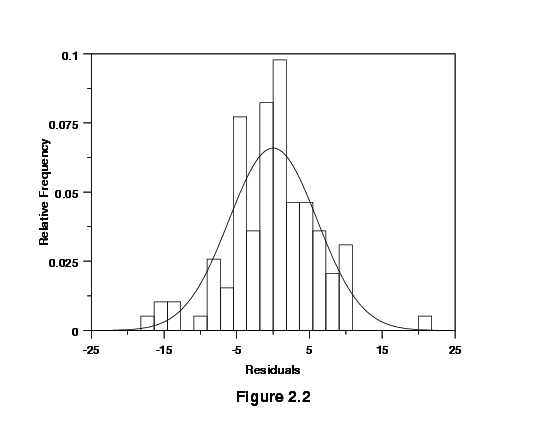
The histogram is a frequency plot obtained by placing the data in
regularly spaced cells and plotting each cell frequency versus
the center of the cell. Figure 2.2 illustrates an approximately normal
distribution of residuals produced by a model for a calibration
process. We have superimposed a normal density function on the
histogram.
|
|
Small sample sizes
|
Sample sizes of residuals are generally small (<50) because
experiments have limited treatment combinations, so a histogram is
not be the best choice for judging the distribution of residuals. A
more sensitive graph is the normal probability plot.
|
|
Normal probability plot
|
The steps in forming a normal probability plot are:
The normal probability plot should produce an approximately straight
line if the points come from a normal distribution.
|
|
Sample normal probability plot with overlaid dot plot
|
Figure 2.3 below illustrates the normal probability graph created from
the same group of residuals used for Figure 2.2.
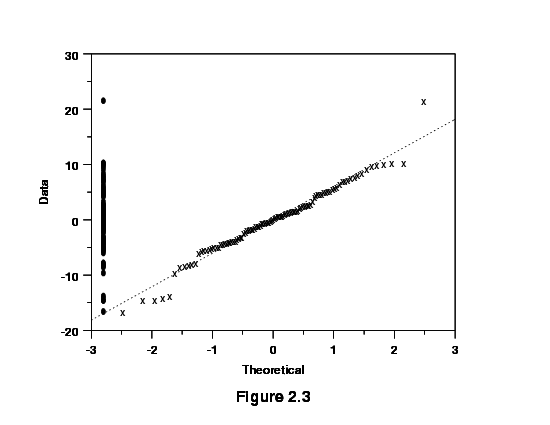
This graph includes the addition of a dot plot. The dot plot is the
collection of points along the left y-axis. These are the values
of the residuals. The purpose of the dot plot is to provide an
indication the distribution of the residuals.
|
|
"S" shaped curves indicate bimodal distribution
|
Small departures from the straight line in the normal probability plot
are common, but a clearly "S" shaped curve on this graph suggests a
bimodal distribution of residuals. Breaks near the middle of this graph
are also indications of abnormalities in the residual distribution.
NOTE: Studentized residuals are residuals converted to a scale
approximately representing the standard deviation of an individual
residual from the center of the residual distribution. The technique
used to convert residuals to this form produces a Student's t
distribution of values.
|
|
|
Independence of Residuals Over Time
|
|
Run sequence plot
|
If the order of the observations in a data table represents the order
of execution of each treatment combination, then a plot of the residuals
of those observations versus the case order or time order of the
observations will test for any time dependency. These are referred
to as run sequence plots.
|
|
Sample run sequence plot that exhibits a time trend
|
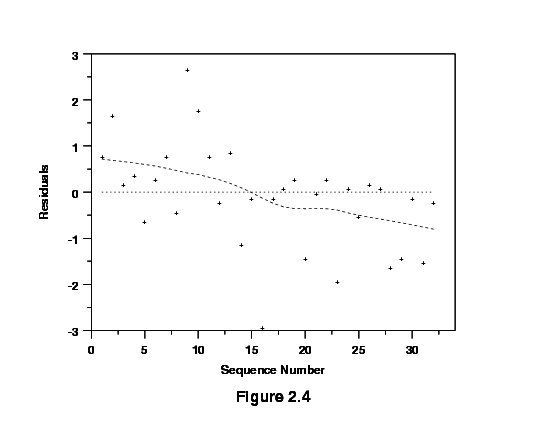
|
|
Sample run sequence plot that does not exhibit a time trend
|
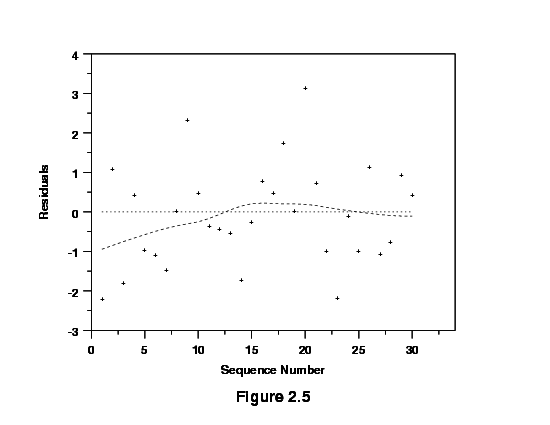
|
|
Interpretation of the sample run sequence plots
|
The residuals in Figure 2.4 suggest a time trend, while those in Figure
2.5 do not. Figure 2.4 suggests that the system was drifting slowly to
lower values as the investigation continued. In extreme cases a drift
of the equipment will produce models with very poor ability to account
for the variability in the data (low R2).
If the investigation includes centerpoints, then plotting them in time
order may produce a more clear indication of a time trend if one exists.
Plotting the raw responses in time sequence can also sometimes detect
trend changes in a process that residual plots might not detect.
|
|
|
Plot of Residuals Versus Corresponding Predicted Values
|
|
Check for increasing residuals as size of fitted value increases
|
Plotting residuals versus the value of a fitted response should produce
a distribution of points scattered randomly about 0, regardless of the
size of the fitted value. Quite commonly, however, residual values may
increase as the size of the fitted value increases. When this happens,
the residual cloud becomes "funnel shaped" with the larger end toward
larger fitted values; that is, the residuals have larger and larger
scatter as the value of the response increases. Plotting the absolute
values of the residuals instead of the signed values will produce a
"wedge-shaped" distribution; a smoothing function is added to each
graph which helps to show the trend.
|
|
Sample residuals versus fitted values plot showing increasing
residuals
|
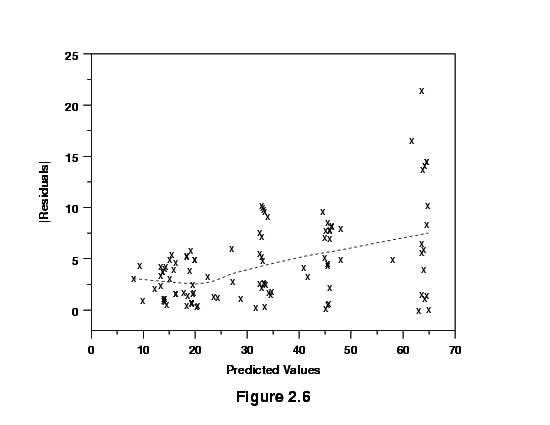
|
|
Sample residuals versus fitted values plot that does not show increasing
residuals
|
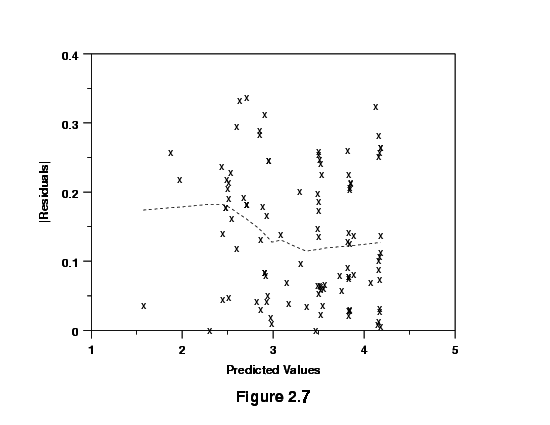
|
|
Interpretation of the residuals versus fitted values plots
|
A residual distribution such as that in Figure 2.6 showing a trend to
higher absolute residuals as the value of the response increases
suggests that one should transform the response, perhaps by modeling
its logarithm or square root, etc., (contractive transformations).
Transforming a response in this fashion often simplifies its
relationship with a predictor variable and leads to simpler models.
Later sections discuss transformation in more detail. Figure 2.7 plots
the residuals after a transformation on the response variable was
used to reduce the scatter. Notice the difference in scales on the
vertical axes.
|
|
|
Independence of Residuals from Factor Settings
|
|
Sample residuals versus factor setting plot
|
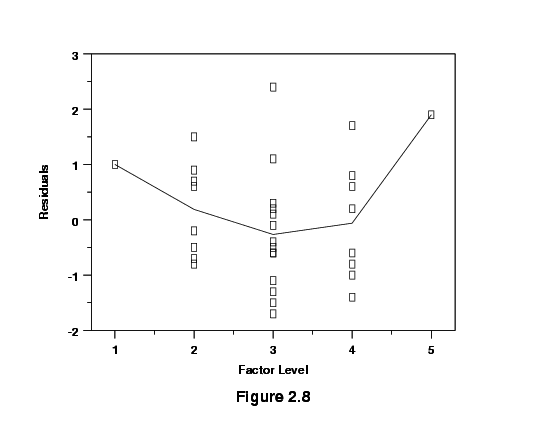
|
|
Sample residuals versus factor setting plot after adding a
quadratic term
|
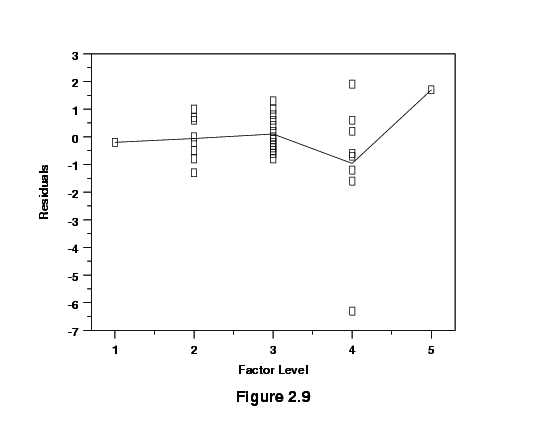
|
|
Interpreation of residuals versus factor setting plots
|
Figure 2.8 shows that the size of the residuals changed as a function
of a predictor's settings. A graph like this suggests that the model
needs a higher-order term in that predictor or that one should
transform the predictor using a logarithm or square root, for example.
Figure 2.9 shows the residuals for the same response after adding a
quadratic term. Notice the single point widely separated from the other
residuals in Figure 2.9. This point is an "outlier." That is, its
position is well within the range of values used for this predictor in
the investigation, but its result was somewhat lower than the model
predicted. A signal that curvature is present is a trace resembling a
"frown" or a "smile" in these graphs.
|
|
Sample residuals versus factor setting plot lacking one or
more higher-order terms
|
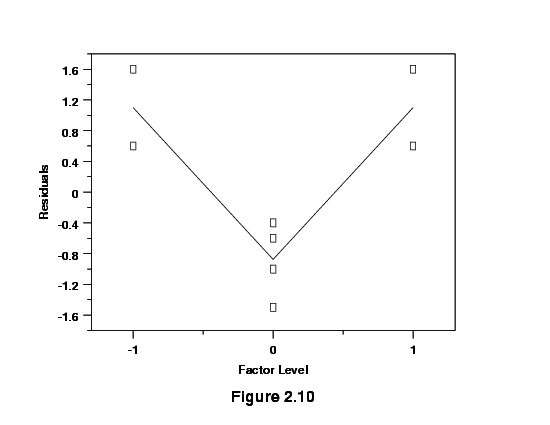
|
|
Interpretation of plot
|
The example given in Figures 2.8 and 2.9 obviously involves five levels
of the predictor. The experiment utilized a response surface design.
For the simple factorial design that includes center points, if the
response model being considered lacked one or more higher-order terms,
the plot of residuals versus factor settings might appear as in
Figure 2.10.
|
|
Graph indicates prescence of curvature
|
While the graph gives a definite signal that curvature is present,
identifying the source of that curvature is not possible due to the
structure of the design. Graphs generated using the other predictors
in that situation would have very similar appearances.
|
|
Additional discussion of residual analysis
|
Note: Residuals are an important subject discussed repeatedly
in this Handbook. For example, graphical residual plots
are discussed in Chapter 1
and the general examination of residuals as a part of model building is
discussed in Chapter 4.
|










